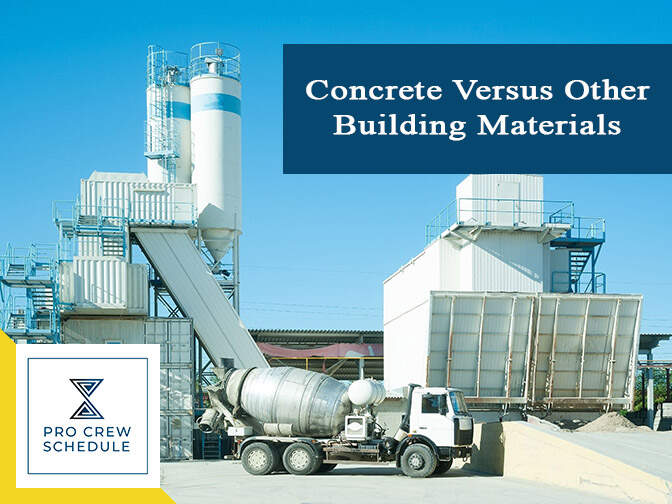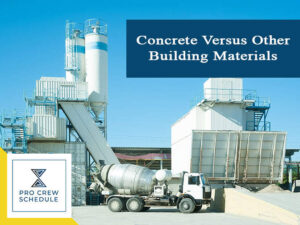A building structure is only as good as its foundation. When talking about the people, the very hands that build the structure, a building might not even see the light of day without an effective project management tools to aid the managers in keeping track of the progress and their crew to ensure a safe and smooth process. Construction-wise, it’s safe to say that without foundation made of sturdy materials, the building will most likely end up crumbling because it was flimsy and weak, to begin with. That’s why a good construction schedule software coupled with high-quality materials is key to making a safe, functional, and appealing building structure come to fruition.
Concrete, a staple in the construction industry, is used in almost all building projects. From commercial buildings to residential walkways, concrete is used in all of these. Paired with a subcontractor scheduling software to manage the skilled concrete workers, this composite material can make many anything in construction, like walls, floors, and support structures.
The quality of concrete
Many believe that they can have a successful construction project if they have the best construction management software installed on their computers and a crew of highly-skilled workers with a good grasp of their field. In addition to those, the right materials also dictate the efficiency and strength of a building project. A well-made foundation, a highly-skilled crew, an effective builder schedule, and a successful construction project is a guarantee.
As it is widely known that concrete makes up a plethora of building structures, it’s critical not to downplay its quality. Even though the aggregates-to-water ratio will, at some level, determine the condition on the concrete, it will also be highly dependent on the grade of the materials mixed in.
But because construction projects need massive amounts of this material, many project managers cheap out on concrete and purchase kinds that don’t do too much damage to the budget. While there are good quality ones available at a reasonable price, unfortunately, choosing quality over quantity can jeopardize the project and the workers’ safety and building occupants.
That’s why it is important to remember these qualities when choosing concrete:
a.Strength and weather-resistance
As concrete commonly makes up the skeletal structure, it must be stable and durable. Additionally, in any construction project, the goal is for the building to stand for a long-time. So aside from merely being strong to support the building itself with its occupants, activities, and furniture, it has to withstand natural elements.
In short, the goal of concrete is to stand against any element, both natural and artificial, and hold up through any wear and tear it goes through. Using low-grade materials will result in an unsafe structure and a shorter lifespan.
b.Workability
Workability refers to using this material, including mixing, handling, transporting, and placing. What is considered workable concrete is one that can hold well against segregation and has an ample amount of time between placing and hardening.
This is directly related to designs and aesthetics. For many building structures, concrete plays an important in its design. With workable concrete, the molding and shaping of various design structures will be more comfortable and will also have better quality and strength.
The Difference Between Concrete, Mortar, and Cement
To the untrained person, concrete, mortar, and cement may look like the same thing. All three of them are versatile construction substances that start out dry but harden for flat surfaces, molded to form various fixtures, or bind other materials together when water is added. While they have many similarities among them, they actually three different materials.
What is cement?
Cement is the common denominator between mortar and concrete. Commonly made from crushed limestone, clay, shells, and silica sand, cement is a mix of those with other ingredients, which are heated to about 2,700 ℉. Then, the “clinker,” as the heated materials are called, ground up into a fine powder and packaged to be mixed with other cementitious construction products such as concrete and mortar.
What is concrete?
Made of cement, sand, and fine and coarse aggregates (i.e., gravel), concrete is strong enough to produce several masonry structures, such as foundation walls, pathways, and columns. The cement in the mix will activate when water is added and will then harden after some time.
What is mortar?
Besides cement, mortar is composed of fine sands and lime to enhance the product’s durability. Like concrete, water is added to activate the cement to cure or harden for the project. The only difference is that it is not as durable as cement, so it mostly acts as a binding agent rather than a building material.
Concrete vs. Other Building Materials
Other than concrete, other building materials are also widely used in construction. Among these are wood, steel, and clay bricks. Comparing them to concrete, will there be a definitive answer to the question, “What is the best building material?”
Concrete vs. Wood
a.Resistance and Safety
In terms of resistance, concrete is the clear winner. Structures with wooden framing are considered less safe because they:
● Are fire-prone;
● More susceptible to decay and moisture, which can start to spread molds, causing a slew of health issues; and
● Attract termites.
b.Cost
When it comes to cost-efficiency, both wood and concrete have their merits and drawbacks. On the one hand, concrete utilizes heavy machinery and materials and need deep foundations, which adds to the construction cost. However, since it is sturdier than wood, there would be fewer structural issues in the future. Concrete is also energy-efficient because it does not need much to heat or cold.
On the other hand, Wood is cheaper during construction as it has a quicker turnaround time by about 30%. But, because of the numerous structural issues linked to it, there may be more expenses for repairs in the long run.
c.Work efficiency
Wood gets the point for work efficiency. In addition to it being lightweight and easy to transport, wood is somewhat easier to use than concrete. This makes it easy to remodel and faster to complete, whereas concrete would take longer to build.
Concrete vs. Steel
a.Strength
While concrete is relatively durable and compressively strong, it lacks the tensile strength steel has. It needs to be reinforced with other materials, such as metal bars, to improve elasticity and ductility.
b.Resistance
Compared to timber, steel is more fire-resistant. But when it is exposed to high enough temperatures, its strength can be compromised. As a solution, steel must be coated in fire-resistant materials to ensure maximum safety, as the IBC (International Building Codes) requires. This makes concrete safer when it comes to fire protection. The cement, sand, and aggregates its made up of makes it naturally fire-resistant.
Steel is also vulnerable to rusting and corrosion when exposed to moisture for enough time. Concrete, on the other hand, can stand against the wear and tear the changing weather can bring. But it’s important to note that the metal reinforcement in concrete should be exposed to water.
c.Cost
Because most of the steel today is made up of recycled A992 steel, it’s significantly cheaper than concrete. Additionally, concrete takes much longer to work with, so labor costs would also go up.
Concrete blocks vs. Clay bricks
a.Strength
Both concrete blocks and clay bricks are considered solid building materials but with a slight difference. According to Mechanical Properties of Unreinforced Brick Masonry, the average brick can resist 3000 psi while the average block can withstand 3500 psi. Moreover, the quality of the binding agent used on them will also determine the wall’s strength.
b.Cost
Both materials are relatively inexpensive. As of 2011, the estimated prices for concrete blocks are as follows:
● A single 8-inch concrete block – $1.35;
● Special lightweight blocks – $3.00 each;
● *A single clay brick – $1.50
But labor is a determining factor that tells whether prices go up or not. One large block would cost about $11.00 to be installed and heavier ones would be approximately $15.00.
c.Ease of installment
The ease of installment would be dependent on the materials’ weights. Although both are considered weighty materials, the materials and type of construction would determine their weight.
A traditional 8-inch block weighs 43 pounds each, but a lightweight block, or autoclaved aerated concrete, contains as much as 80% air, making it that much lighter than a conventional concrete block.
Clay bricks only way about 5 pounds each, making it very easy to handle and be installed.
Hiring Skilled and Qualified Concrete Contractors
As it was previously mentioned, workers are the very hands that build the structure. So, it only makes sense to hire the best contractors to ensure a safe and successful project. Here’s how to choose the best concrete contractor for the job.
1.Research
It all starts with research and there are many ways you make sure you have a list of potential contractors.
● Simple Internet research can give names of people who are skilled and qualified.
● Ask friends or relatives for referrals.
● Physically go to companies and ask them for referrals.
With a well-structured list with many options, you can continue your research to see who is the best fit.
2.Look for experience
While it’s good to give newbies a chance, you don’t want to risk giving the job to an inexperienced contractor and messing up the project. Contractors with at least five years of experience can give you a sense of reliability and stability.
3.Confirm insurance
Construction is a dangerous industry to work in. So, hiring contractors with verified insurance can excuse you from being liable. Some added insurance security could keep both the management and the crew safe.
4.Look into references
Contacting their references get give a bit of background and confirm that they are qualified for the job. Consequently, you can also see if they have had negative past experiences with the person applying to be the contractor.







